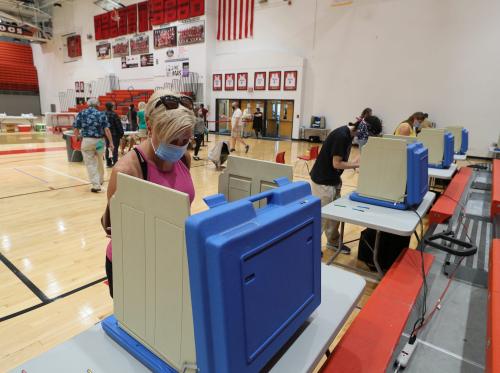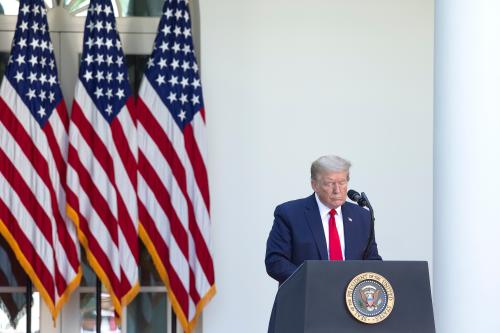So far in his re-election campaign, President Trump has stubbornly refused to expand his base, playing instead to a brand of populist conservatism that rests on solid support from white working-class voters. But a Pew Research Center survey released at the end of June suggests that voters in this group under age 40 are breaking ranks. They are less likely to say that they plan to vote for the president this November than are their parents and grandparents, they question his competence to handle the major issues facing the country, and they have formed a negative assessment of his character.
The same poll shows that 87% of Americans are dissatisfied with the way things are going, and only 17% are proud of the country’s condition. Only 39% approve of how Donald Trump is handling his job as president, and former Vice President Joe Biden leads him by 10 percentage points, 54-44.
Against this backdrop, the erosion in the Trump white working-class base is a major blow to the president’s reelection chances. As the following tables show, weakness appears in four areas tested by the poll—voting intentions, assessments of Trump’s presidency and character, and judgments on his handling of key issues.
Table 1: Voting intentions of white working-class voters by age
| 18-39 | 40-64 | 65+ | |
| Voting for/leaning toward Trump | 55% | 66% | 62% |
| Voting for/leaning toward Biden | 40% | 32% | 35% |
Former Vice President Biden doesn’t hold any special appeal for white working-class voters under 40. Indeed, voters over 65 are more likely to think well of him. Of the 40% of young voters who support Biden, only 5% express approval of him, while 35% say they that they will be casting a vote against President Trump. As Table 2 shows, a plurality of these voters think that the Trump presidency is a failure.
Table 2: Has Trump been a good president? (White working-class voters by age)
| 18-39 | 40-64 | 65+ | |
| Trump has been a good or great president | 44% | 59% | 57% |
| Trump has been a poor or terrible president | 46% | 31% | 37% |
President Trump’s competence
Table 3 summarizes white working-class voters’ confidence that the president can address key issues “very” or “somewhat” well.
Table 3: Trump’s handling of issues among white working-class voters by age
| 18-39 | 40-64 | 65+ | |
| Handle the coronavirus outbreak | 46% | 64% | 59% |
| Make good decisions about foreign policy | 47% | 67% | 61% |
| Make good decisions about economic policy | 57% | 72% | 66% |
| Effectively handle race relations | 35% | 57% | 55% |
| Effectively handle law enforcement and criminal justice | 46% | 65% | 60% |
| Bring the country together | 35% | 51% | 47% |
President Trump’s character
Table 4 summarizes white working-class voters’ belief that certain words describe Mr. Trump “very” or “fairly” well.
Table 4: Descriptions of President Trump among white working-class voters by age
| 18-39 | 40-64 | 65+ | |
| Courageous | 50% | 66% | 61% |
| Honest | 41% | 58% | 54% |
| Even-tempered | 26% | 42% | 39% |
| Cares about the needs of ordinary people | 46% | 64% | 59% |
| A good role model | 34% | 50% | 50% |
Here, as with questions of competence, there is a consistent difference between white working-class voters under age 40 and older voters. Among the plausible hypotheses: the younger members of this group are more comfortable with diversity and less moved by the memory of vanished high-pay manufacturing jobs. While we can speculate about the reasons for this difference, only further research can clarify them.
Losing the future
After the 2012 election, Republican leaders issued a report recommending that their party reach out to younger and non-white voters. Four years later, Donald Trump shocked the world by doing the reverse—and winning. But the question remains: as education and demography have made white working-class voters a shrinking share of the electorate, was Trump’s victory a harbinger of the future or the last gasp of a dying order?
The results summarized in this article suggest that the latter is more likely. If even younger white Americans without college degrees are turning away from what the Republican Party has become, the choice Mr. Trump represents is a cul de sac.
We will not know until the votes are cast. But if current surveys are leading indicators, after November 3rd the Republican Party will be forced to debate its future more fundamentally than at any time since the 1970s.
A note on method: All numbers are for registered voters, and the differences between 18-39-year-olds and other age groups are statistically significant. I am grateful to the Pew team, and especially to Calvin Jordan, for their patient responsiveness to my endless requests for additional information.







Commentary
President Trump is losing support among young white working-class voters
July 6, 2020